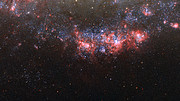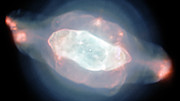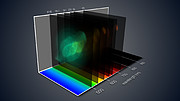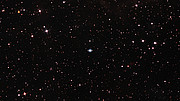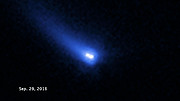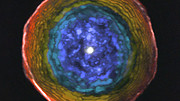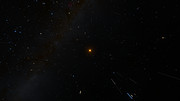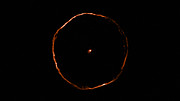He 2-47, NGC 5315, IC 4593 and NGC 5307
The colorful, intricate shapes in these NASA Hubble Space Telescope
images reveal how the glowing gas ejected by dying Sun-like stars
evolves dramatically over time.
These gaseous clouds, called planetary nebulae, are created when
stars in the last stages of life cast off their outer layers of material
into space. Ultraviolet light from the remnant star makes the material
glow. Planetary nebulae last for only 10,000 years, a fleeting episode
in the 10-billion-year lifespan of Sun-like stars.
The name planetary nebula has nothing to do with planets. They got
their name because their round shapes resembled planets when seen
through the small telescopes of the eighteenth century.
The Hubble images show the evolution of planetary nebulae, revealing
how they expand in size and change temperature over time. A young
planetary nebula, such as He 2-47, at top, left, for example, is small
and is dominated by relatively cool, glowing nitrogen gas. In the Hubble
images, the red, green, and blue colors represent light emitted by
nitrogen, hydrogen, and oxygen, respectively.
Over thousands of years, the clouds of gas expand away and the
nebulae become larger. Energetic ultraviolet light from the star
penetrates more deeply into the gas, causing the hydrogen and oxygen to
glow more prominently, as seen near the center of NGC 5315. In the older
nebulae, such as IC 4593, at bottom, left, and NGC 5307, at bottom,
right, hydrogen and oxygen appear more extended in these regions, and
red knots of nitrogen are still visible.
These four nebulae all lie in our Milky Way Galaxy. Their distances
from Earth are all roughly the same, about 7,000 light-years. The
snapshots were taken with Hubble's Wide Field Planetary Camera 2 in
February 2007. Like snowflakes, planetary nebulae show a wide variety of
shapes, indicative of the complex processes that occur at the end of
stellar life.
He 2-47, at top, left, is dubbed the "starfish" because of its shape.
The six lobes of gas and dust, which resemble the legs of a starfish,
suggest that He 2-47 puffed off material at least three times in three
different directions. Each time, the star fired off a narrow pair of
opposite jets of gas. He 2-47 is in the southern constellation Carina.
NGC 5315, the chaotic-looking nebula at top, right, reveals an
x-shaped structure. This shape suggests that the star ejected material
in two different outbursts in two distinct directions. Each outburst
unleashed a pair of diametrically opposed outflows. NGC 5315 lies in the
southern constellation Circinus.
IC 4593, at bottom, left, is in the northern constellation Hercules.
NGC 5307, at bottom, right, displays a spiral pattern, which may have
been caused by the dying star wobbling as it expelled jets of gas in
different directions. NGC 5307 resides in the southern constellation
Centaurus.
For more information, contact:
Donna Weaver/Ray Villard
Space Telescope Science Institute, Baltimore, Md.
410-338-4493/4514
dweaver@stsci.edu / villard@stsci.edu
Keith Noll
Space Telescope Science Institute, Baltimore, Md.
410-338-1828
noll@stsci.edu



